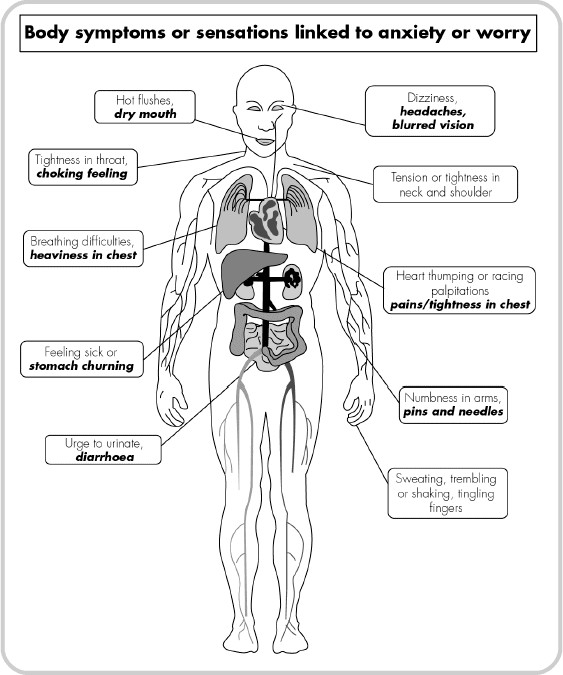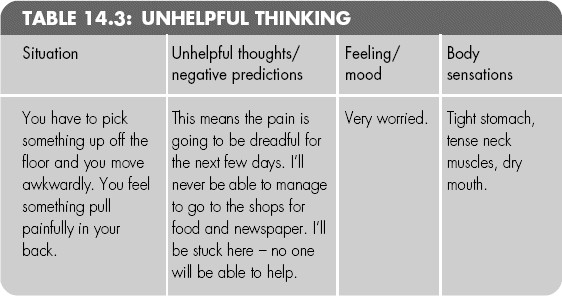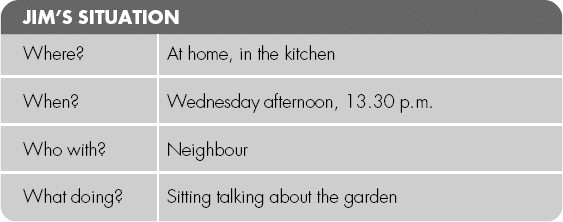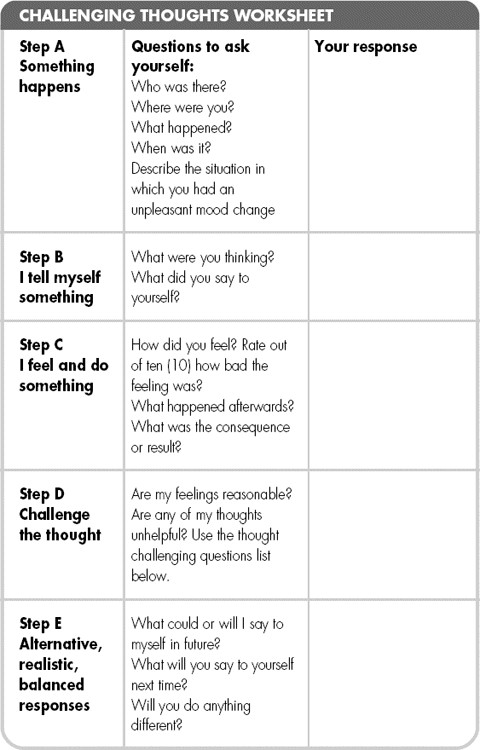
- •Other titles in the series include:
- •Overcoming chronic pain a self-help manual using Cognitive Behavioral Techniques frances cole, helen macdonald, catherine carus and hazel howden-leach
- •Isbn: 978-1-84119-970-2 eIsbn: 978-1-47210-573-8
- •Table of contents
- •Acknowledgements
- •Foreword
- •Introduction by Peter Cooper Why cognitive behavioral?
- •Introduction
- •Who might benefit from using this book?
- •What does chronic pain mean?
- •What is Cognitive Behavioral Therapy?
- •How can a book help?
- •How can I get the most out of using this book?
- •What do the chapters cover?
- •How do I start using this book?
- •Four case histories
- •Using the person-centred model
- •Maria and the person-centred model
- •How did the model help Maria make changes for the better?
- •How can the person-centred model help you get ready tomake some changes?
- •Getting started
- •Reducing the impact of pain on your daily life
- •How do you or others see these changes occurring?
- •Understanding chronic pain and pain systems
- •Understanding pain
- •Acute and chronic pain
- •What is acute pain?
- •What is chronic pain?
- •Acute and chronic pain systems
- •The acute pain system
- •The chronic pain system
- •Theories of pain The Gate Control Theory of Pain
- •Other theories of pain
- •Frequently asked questions
- •Understanding investigations for pain
- •Blood tests
- •Waiting for tests and results
- •Understanding the roles of healthcare professionals
- •Healthcare professionals
- •What is the role of a physiotherapist?
- •How do physiotherapists work?
- •What is the role of a specialist pain nurse?
- •What is the role of a pain specialist?
- •What is the role of a psychologist?
- •What is the role of a psychiatrist?
- •Talking therapies
- •Cognitive Behavioral Therapy
- •Pain management programmes
- •Understanding medicines and using them better
- •What types of medicines are used to manage chronic pain?
- •How are medicines used? Analgesics
- •Problems with medicines
- •Making better use of medicines
- •Four suggestions for using medications more helpfully
- •Stopping or reducing your medicines
- •Part two Overcoming Chronic Pain
- •Introduction
- •Setting goals
- •What are goals?
- •Informal and formal goals
- •What are smart goals?
- •Setting goals
- •Using a goal ladder
- •Achieving your goals
- •Giving yourself rewards
- •What are rewards?
- •Creating a ‘fun presciption’
- •50 Mg of fun three times a day (at least) For maximum benefit, use imagination!
- •Understanding pacing skills
- •What is pacing?
- •What are the different styles of pacing?
- •What type of pacing style do you use at present?
- •If pain levels are low, do you:
- •If pain levels are high, do you:
- •How to change your pacing style
- •Experimenting
- •Planning
- •Priorities
- •How to deal with barriers to realistic pacing
- •Getting fitter and being more active
- •How being more active can help you manage your pain
- •Trying to get fitter: What does having more pain mean?
- •Why do these types of activity cause aches and pains?
- •Assessing your present activity level
- •Frequently asked questions about increasing physical activity
- •How to get started on a basic exercise programme
- •Strength exercises – do slowly
- •Stretches for flexibility
- •Understanding problem-solving
- •What is problem-solving?
- •The main steps in problem-solving
- •Putting the problem-solving process into practise
- •Problem-solving guide
- •Understanding sleep and sleep problems
- •What sort of sleeping problems can be caused by chronic pain?
- •What kind of sleep pattern do you have at present?
- •How much sleep do you need?
- •How to use a sleep diary
- •How can you change unhelpful sleep habits?
- •Relaxation
- •What is relaxation?
- •How can relaxation help with chronic pain?
- •What can help you relax?
- •How to practise relaxing
- •Time out relaxation
- •What can make it difficult to practise relaxation?
- •Pain, communication and relationships
- •Part 1: communication and sharing concerns How close relationships can be affected by pain
- •How to manage difficulties in relationships
- •How to change behavior
- •How to communicate and share your concerns
- •Part 2: chronic pain and sexual relationships
- •How to deal with sexual problems
- •How to make sexual relationships easier
- •Managing depression, anxiety and anger
- •What moods can occur because of pain?
- •Part 1: managing depression
- •Why do people become depressed with chronic pain?
- •How depression affects people’s thinking
- •What factors can contribute to depression?
- •Unhelpful thinking in depression
- •Using anti-depressants
- •Part 2: managing anxiety
- •What is anxiety?
- •What are the effects of anxiety?
- •How does anxiety affect the body?
- •Anxiety and chronic pain
- •Managing anxiety by dealing with unhelpful thinking
- •Overcoming avoidance
- •Changing unhelpful behaviors
- •Part 3: managing anger
- •How anger affects you and your pain
- •How chronic pain and anger are linked
- •How being angry can affect other people
- •How to manage anger better
- •A coping plan
- •Acceptance
- •What is acceptance?
- •How can acceptance help you manage chronic pain?
- •What is attentional control or mindfulness?
- •1. Reasonable (thinking reasonably)
- •2. Emotional (thinking emotionally)
- •3. Wise (being mindful)
- •Mindfulness skills
- •1. Observing
- •2. Being ‘non-judgemental’
- •3. Focusing on one thing now and being in the present
- •4. Doing what works
- •Mindfulness exercises
- •Maintaining progress and managing setbacks
- •How can you maintain progress?
- •Obstacles to progress
- •What is a setback?
- •How can you manage a setback?
- •Looking to the future and managing work
- •How are new ways of life and new roles possible?
- •How can you use a positive data log?
- •Thinking through work, training and other options
- •How can you stay at work or return to work successfully?
- •Useful information
- •Professional organizations
- •Self-help groups and organizations
- •Books and publications
- •Self-help books
- •Tapes and cDs
- •Useful videos
- •Wordlist
How does anxiety affect the body?
Anxiety causes the release of adrenaline. This has many effects in the body. It can make the heart beat faster and stronger or make your muscles tense and ready to do one of the following:
• Freeze on the spot, motionless
• Run as fast as possible, fleeing from the threat or danger
• Fight strongly against the danger or threat
This is known as the ‘fight or flight response’. The release of adrenaline is to protect and deal with danger or threats quickly and effectively. The problem with anxiety is having too much of it, when there is little or no real danger or threat.
Anxiety and chronic pain
People with chronic pain often feel anxious. You may find yourself worried or fearful about many things.
Tick the type of anxious thoughts that you may have. For example:
About the pain itself and its intensity
About the causes of the pain
About body symptoms, such as numbness or sleep problems
About body movements or positions that increase the pain severely
About staying at work or getting back to work or study
About what other people might believe or think about you
About whether people will reject you
About what might happen if you become disabled and dependent on other people, possibly in a wheelchair
Other fears?

Write down any fears or concerns you may have in your notebook.
Managing anxiety by dealing with unhelpful thinking
When you become worried, anxious, scared or frightened, your thinking is likely to change in three ways. You may:
• Over-estimate the danger, the seriousness of the threat, or how vulnerable you are.
• Under-estimate your own ability to cope.
• Under-estimate your own resources or the ‘rescue factors’ in the situation.
Here is an example of how this type of unhelpful thinking works.

This example shows a series of thoughts, or predictions, that increase anxiety. You strongly believe the predictions will happen, which is why you feel so anxious. This makes you feel more tight and tense in your muscles and joints. This, in itself, increases the pain.
WHAT ACTUALLY HAPPENED?
There was a mild increase in pain. The medication reduced it because it was an acute strain pain. The weather was sunny. You were in the garden and your neighbour saw you. She was going to the shops and offered you a lift in the car. You used distraction by working in the garden (using your own resources). The lift from the neighbour was an example of a ‘rescue factor’.
So the predictions were inaccurate and this was an example of unhelpful thinking.
To manage this type of thinking, it helps to try the following actions:
• Identify unhelpful thoughts.
• Challenge unhelpful thinking using a worksheet and ‘thought challenge’ questions.
• Use helpful coping self-talk.
ACTION 1: IDENTIFY UNHELPFUL THOUGHTS
Think about the last time your mood changed to being anxious. Recall what went through your mind at the time. Then tick the style of unhelpful thoughts that you noticed:
• All or nothing Seeing things as either black or white. If something is not perfect, then it must be disastrous, yet life is not that clear-cut. It has many shades of grey.
• Over-generalization After one unfortunate event, assuming this will happen again, every time. There is no reason for seeing one instance as proving a rule for all events for always.
• Mental filter Picking out a negative or worrying detail and dwelling on it exclusively, so seeing the whole situation as bad. This will certainly make you feel worried and you will no doubt be missing out on some positive sides of a situation.
• Disqualifying the positive Anxious people have a strong tendency to say that positive experiences don’t count for some reason. You may say a successful event was a ‘fluke’. You don’t let yourself take pleasure from positive or pleasant events.
• Jumping to conclusions Assuming the worst when there is no real reason to think this way.
• Catastrophic thinking Exaggerating the importance of your own imperfections or errors or fears, e.g. ‘I made a mistake – how awful – I can never show my face here again.’
• Emotional reasoning Believing, because you feel so afraid, that there really must be some danger. Sometimes things or situations feel so dreadful, you believe they really are in a mess. However, these anxious feelings are usually not realistic.
• ’Should’ thinking For instance, thinking you ‘should’ be able to stay calm all the time, or you ‘must’ never get angry. Such rigid thoughts are unreasonable, demanding and cause excessive pressure and, often, guilt feelings.
• Labelling and mis-labelling Labelling yourself ‘a useless person’ on the basis of a mistake you made. So your idea of yourself is because of something you have done? It makes as much sense as calling yourself an ‘electrician’ because you can change a plug!
• Personalization Assuming that when something goes badly, it was entirely your fault. Personalization usually causes guilt. It leads you to assume responsibility for events that are almost certainly due to many factors, not just you and your actions.
ACTION 2: CHALLENGE UNHELPFUL THOUGHTS
When you experience unpleasant anxious moods or emotions, notice what you are thinking.
Ask yourself: ‘What went through my mind as I started to feel worried or scared?’
Moods can be affected by what you are thinking, and what you believe, about a situation. This is how Jim’s thoughts and beliefs helped to make him feel very anxious.

Thoughts (What went through Jim’s mind as he started to feel anxious?)
‘What if I can’t get out to cut the grass and tidy the flower beds? I am so useless. I used to be able to do all the tasks around the house. Everybody will criticize the state of the garden.’
Moods (emotions)
I feel so worried (7/10)
Body sensations
Felt tense in neck and back muscles, felt more pain
So Jim’s thought challenge, using the thought challenge questions on p. 224, looked like this:
Does it make sense to tell myself that I am useless?
Do other people really criticize me because of the state of my garden when I am so limited by severe pain and stiffness?
Are these unhelpful predictions?
Jim’s possible realistic, balanced responses were:
I have tried to get going this morning, the pain is very bad. That doesn’t mean the garden will be in a state just because I am having a difficult day.
I am disappointed not to go out but it does not mean it is terrible.
I don’t need to keep it neat and tidy. It doesn’t reflect on me as a person. I can fail to do things some days without being ‘a failure’.
In future, when I have that thought, I will tell myself I can only do my best at the time.
These realistic responses are likely to lift Jim’s mood making him feel more cheerful and less worried.
So challenging unhelpful thoughts and beliefs can help lessen anxiety and chronic pain. Note: It is balanced, realistic thinking, not simply ‘positive thinking’.
HOW TO USE A CHALLENGING THOUGHTS WORKSHEET
It can take some practise to notice when worried or upsetting thoughts are going through your mind, though sometimes they are all too obvious. Occasionally, anxious feelings are more easily noticed than thoughts. In this case, you can use the middle Step C (‘I feel and do something’) first. Use Step C when you feel anxious. Then go back to Step A (‘Something happens’) and write down what happened, who was there and what you noticed at the time.



Now move to Step B and record what your thoughts were at the time, or what you said to yourself, or pictured in your mind.
Next, use Step D and Step E to start to ‘challenge’ your thoughts, and imagine different ways of seeing the situation. See if this affects your thoughts and lessens your feelings of anxiety by developing more realistic thoughts.
Use the sheet on page 222 to monitor and challenge thoughts that lead to unpleasant anxious moods. Use the ‘Thought challenging questions’ to help with Step D (‘Does it make sense to say this to myself?’).
Use this list of ‘thought challenging questions’ to help you.
• Am I getting things out of proportion?
• If other people were in that situation what would I say to them?
• Am I confusing thoughts with fact? What happened the last time I was in this situation?
• Am I:
(a) thinking in all or nothing terms?
(b) jumping to conclusions?
(c) using catastrophic thinking?
(d) ‘mind reading’?
• Are my thoughts predicting the future in an unhelpful way?
• Am I noticing only the negative side of things?
• Are my judgements made on the basis of feelings rather than facts?
Note: Feedback from people who have used these Challenging Thoughts Worksheets suggests that it’s worth trying them on at least three occasions when you are feeling anxious. It is really helpful to use the sheets until the thought challenge method becomes easy to do and a regular part of your life.
Do persevere. It’s normal to have setbacks or progress slowly. And remember to reward yourself regularly, especially for your efforts (see Chapter 7).
ACTION 3: USE HELPFUL COPING SELF-TALK
Tick those coping self-talk thoughts below you would use when anxious:
Having anxiety is normal.
It shows that I am alert.
Anxiety is simply the effect of adrenaline on the body.
These sensations are not dangerous or serious.
I am having false alarms.
I have made negative predictions before, which have not come true.
I can watch my body sensations increase and decrease.
Just accept it as anxiety passes and goes away.
Others?
You might want to add some of your own and perhaps carry them with you on a card.
There are other useful ways to reduce anxiety and worry, which may help you manage pain and daily life better. For instance, relaxation, especially focusing on your breathing, can lessen the body sensations (see Chapter 12). Try to use your relaxation skills, as they can be a really effective way of reducing mild to moderate anxiety.
